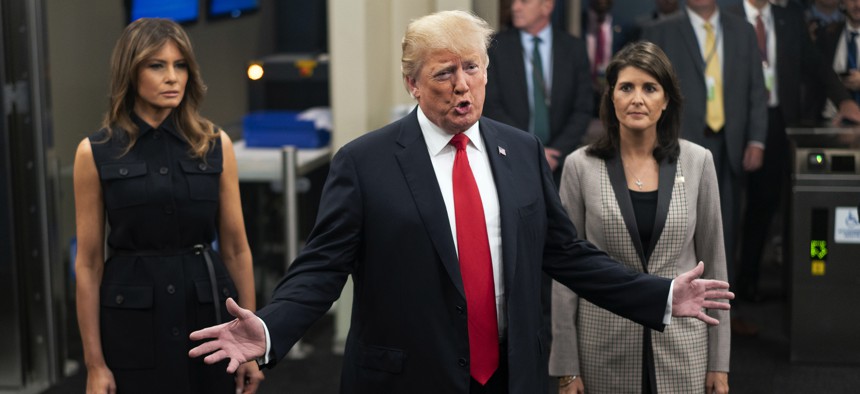
President Donald Trump addresses members of the news media as he arrives with First lady Melania Trump, left, and Nikki Haley, the U.S. ambassador to the United Nations, at U.N. headquarters, Sept. 25, 2018. AP Photo/Craig Ruttle
Trump's 'Maximum-Pressure' Strategy for North Korea and Iran Will Fail
The combined might of punishing sanctions, diplomatic isolation, or even the threat of war won’t compel surrender from North Korea and Iran.
Last week at the United Nations, President Donald Trump claimed his administration had made progress in contending with North Korea, and promised to repeat the same feat with Iran. Heaping praise on North Korea and scorn on Iran, he told reporters, “It doesn't matter what world leaders think of Iran. Iran's going to come back to me and they're going to make a good deal.” Clearly, Trump believes his strategy of maximum pressure—economic sanctions, diplomatic isolation, and even threat of war—will result in historic deals with North Korea and Iran. But even if developments with North Korea have given Trump reason for hope, this is not going to be a winning strategy.
It’s increasingly clear that what Trump hopes to achieve through a maximum-pressure campaign does not align with the vision of his national-security team: Judging by his behavior with Kim and his statement on Iran, his goal is to bring North Korea and Iran into diplomatic talks. Members of his team speak as if they'd rather force their surrender. Pyongyang and Tehran understand this very well.
Indeed, at the United Nations last week, Ri Yong Ho, North Korea’s foreign minister, rejected any move towards denuclearization—the wholesale and unconditional surrender of nuclear and missile programs—unless it came with tangible U.S. concessions. Pressure, in other words, may have persuaded Kim Jong Un to engage, but pressure alone will not get Trump the deal he covets. Despite Trump’s charm offensive, his administration seems to be pursuing what National Security Advisor John Bolton has called the “Libya outcome,” a reference to the 2003 deal in which Muammar al-Qaddafi surrendered Libya’s nuclear program and shipped it out of the country.
North Korea and Iran may deem the cost of not talking to Trump too high, which implies they would engage him—but resisting surrender is their priority. This means that maximum pressure as a guiding strategy will have diminishing value over time. Indeed, if the president’s national-security team continues with maximum pressure in pursuit of surrender, they’ll encounter resistance from Iran and North Korea. Waiting out the Trump presidency or hoping for the policy to implode could become their preferred option.
What North Korea is looking for is a step-by-step diplomatic process in which the United States offers concessions ranging from a declaration of peace on the Korean Peninsula to the lifting of economic sanctions. Instead, Trump’s national-security team is demanding full denuclearization before offering anything up in return. That looks to be what Washington has in mind for Iran as well.
Faced with this reality, Pyongyang or Tehran could see a benefit in resisting Washington’s pressure strategy. Kim is willing to engage in summitry but has yielded little ground on the demand that he unconditionally relinquish his nuclear and missile programs. Iran, for its part, sees little point in going as far as North Korea has. Talking to Trump would effectively kill the international nuclear deal it signed in 2015, which the United States left last May; Trump likely expected that Iran would follow suit, and that he would sign his own deal with Iran. Washington is now ratcheting up economic pressure on Iran, and warning other signatories against doing business with Iran.
Iran is not reaping any economic benefits inside the deal, but it is unlikely to get any outside the deal either, even if it were to talk with Washington. But if Iran did abandon it, it would give up the hard-won right to a nuclear program, which is enshrined in the accord. That is likely why Iran’s President Rouhani said last week that the United States must rejoin the deal before he would talk to President Trump. His thinking: If the Trump administration brought the United States back into the deal, it could no longer look to the Libya model as the goal, and would have to negotiate from the existing baseline of the 2015 deal.
Of course, it’s not only North Korea and Iran alone that bear the brunt of maximum pressure. This is a policy levied at the entire international community, which will likely resist, potentially leading to the policy’s implosion. Indeed, if America’s isolation at last week’s United Nations Security Council special session, in which it tried to rally support for its policy on Iran is any indication, maximum pressure has little international backing. While the maximum-pressure strategy received initial support in China and South Korea, that support began to wane after Pyongyang agreed to the Singapore Summit. The United States is also threatening its European allies with punishment if they facilitate business with Iran, and India is being forced to forego its investment in the port of Chabahar in Southeast Iran, a gateway to Afghanistan and Central Asia that allows India to balance China’s regional influence. U.S. pressure, meanwhile, has already led Europe, China, and Russia to explore ways to circumvent U.S. sanctions pressure.
What all this means: The wanton use of maximum pressure by Washington is likely to create a world in which the United States is unable to exercise much pressure at all.



